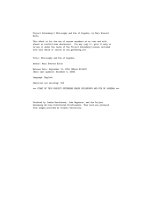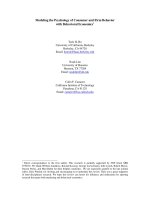Project Gutenberg''''s The Works of Edgar Allan Poe, by Edgar Allan Poe pptx
Bạn đang xem bản rút gọn của tài liệu. Xem và tải ngay bản đầy đủ của tài liệu tại đây (1.5 MB, 719 trang )
Project Gutenberg's The Works of Edgar
Allan Poe, by Edgar Allan Poe
This eBook is for the use of anyone
anywhere at no cost and with
almost no restrictions whatsoever. You
may copy it, give it away or
re-use it under the terms of the Project
Gutenberg License included
with this eBook or online at
www.gutenberg.org
Title: The Works of Edgar Allan Poe
Volume 4 (of 5) of the Raven
Edition
Author: Edgar Allan Poe
Release Date: May 19, 2008 [EBook #2150]
Last Updated: March 31, 2012
Language: English
*** START OF THIS PROJECT GUTENBERG EBOOK
THE WORKS OF EDGAR ALLAN POE ***
Produced by David Widger
THE WORKS OF
EDGAR ALLAN
POE
IN FIVE VOLUMES
VOLUME FOUR
The Raven Edition
CONTENTS
THE DEVIL IN THE BELFRY
LIONIZING
X-ING A PARAGRAPH
METZENGERSTEIN
THE SYSTEM OF DOCTOR
TARR AND PROFESSOR
FETHER
HOW TO WRITE A
BLACKWOOD ARTICLE.
A PREDICAMENT
MYSTIFICATION
DIDDLING
THE ANGEL OF THE ODD
MELLONTA TAUTA
THE DUC DE L'OMELETTE.
THE OBLONG BOX.
LOSS OF BREATH
THE MAN THAT WAS USED
UP.
THE BUSINESS MAN
THE LANDSCAPE GARDEN
MAELZEL'S CHESS-PLAYER
THE POWER OF WORDS
THE COLLOQUY OF MONOS
AND UNA
THE CONVERSATION OF
EIROS AND CHARMION
SHADOW—A PARABLE
THE DEVIL IN THE
BELFRY
What o'clock is it?—Old Saying.
EVERYBODY knows, in a general
way, that the finest place in the world is—
or, alas, was—the Dutch borough of
Vondervotteimittiss. Yet as it lies some
distance from any of the main roads, being
in a somewhat out-of-the-way situation,
there are perhaps very few of my readers
who have ever paid it a visit. For the
benefit of those who have not, therefore, it
will be only proper that I should enter into
some account of it. And this is indeed the
more necessary, as with the hope of
enlisting public sympathy in behalf of the
inhabitants, I design here to give a history
of the calamitous events which have so
lately occurred within its limits. No one
who knows me will doubt that the duty
thus self-imposed will be executed to the
best of my ability, with all that rigid
impartiality, all that cautious examination
into facts, and diligent collation of
authorities, which should ever distinguish
him who aspires to the title of historian.
By the united aid of medals,
manuscripts, and inscriptions, I am
enabled to say, positively, that the
borough of Vondervotteimittiss has
existed, from its origin, in precisely the
same condition which it at present
preserves. Of the date of this origin,
however, I grieve that I can only speak
with that species of indefinite definiteness
which mathematicians are, at times, forced
to put up with in certain algebraic
formulae. The date, I may thus say, in
regard to the remoteness of its antiquity,
cannot be less than any assignable quantity
whatsoever.
Touching the derivation of the name
Vondervotteimittiss, I confess myself,
with sorrow, equally at fault. Among a
multitude of opinions upon this delicate
point—some acute, some learned, some
sufficiently the reverse—I am able to
select nothing which ought to be
considered satisfactory. Perhaps the idea
of Grogswigg—nearly coincident with
that of Kroutaplenttey—is to be cautiously
preferred.—It runs:—"Vondervotteimittis
—Vonder, lege Donder—Votteimittis,
quasi und Bleitziz—Bleitziz obsol:—pro
Blitzen." This derivative, to say the truth,
is still countenanced by some traces of the
electric fluid evident on the summit of the
steeple of the House of the Town-Council.
I do not choose, however, to commit
myself on a theme of such importance, and
must refer the reader desirous of
information to the "Oratiunculae de Rebus
Praeter-Veteris," of Dundergutz. See, also,
Blunderbuzzard "De Derivationibus," pp.
27 to 5010, Folio, Gothic edit., Red and
Black character, Catch-word and No
Cypher; wherein consult, also, marginal
notes in the autograph of Stuffundpuff,
with the Sub-Commentaries of
Gruntundguzzell.
Notwithstanding the obscurity which
thus envelops the date of the foundation of
Vondervotteimittis, and the derivation of
its name, there can be no doubt, as I said
before, that it has always existed as we
find it at this epoch. The oldest man in the
borough can remember not the slightest
difference in the appearance of any
portion of it; and, indeed, the very
suggestion of such a possibility is
considered an insult. The site of the
village is in a perfectly circular valley,
about a quarter of a mile in circumference,
and entirely surrounded by gentle hills,
over whose summit the people have never
yet ventured to pass. For this they assign
the very good reason that they do not
believe there is anything at all on the other
side.
Round the skirts of the valley (which is
quite level, and paved throughout with flat
tiles), extends a continuous row of sixty
little houses. These, having their backs on
the hills, must look, of course, to the
centre of the plain, which is just sixty
yards from the front door of each
dwelling. Every house has a small garden
before it, with a circular path, a sun-dial,
and twenty-four cabbages. The buildings
themselves are so precisely alike, that one
can in no manner be distinguished from the
other. Owing to the vast antiquity, the style
of architecture is somewhat odd, but it is
not for that reason the less strikingly
picturesque. They are fashioned of hard-
burned little bricks, red, with black ends,
so that the walls look like a chess-board
upon a great scale. The gables are turned
to the front, and there are cornices, as big
as all the rest of the house, over the eaves
and over the main doors. The windows
are narrow and deep, with very tiny panes
and a great deal of sash. On the roof is a
vast quantity of tiles with long curly ears.
The woodwork, throughout, is of a dark
hue and there is much carving about it,
with but a trifling variety of pattern for,
time out of mind, the carvers of
Vondervotteimittiss have never been able
to carve more than two objects—a time-
piece and a cabbage. But these they do
exceedingly well, and intersperse them,
with singular ingenuity, wherever they
find room for the chisel.
The dwellings are as much alike inside
as out, and the furniture is all upon one
plan. The floors are of square tiles, the
chairs and tables of black-looking wood
with thin crooked legs and puppy feet. The
mantelpieces are wide and high, and have
not only time-pieces and cabbages
sculptured over the front, but a real time-
piece, which makes a prodigious ticking,
on the top in the middle, with a flower-pot
containing a cabbage standing on each
extremity by way of outrider. Between
each cabbage and the time-piece, again, is
a little China man having a large stomach
with a great round hole in it, through
which is seen the dial-plate of a watch.
The fireplaces are large and deep, with
fierce crooked-looking fire-dogs. There is
constantly a rousing fire, and a huge pot
over it, full of sauer-kraut and pork, to
which the good woman of the house is
always busy in attending. She is a little fat
old lady, with blue eyes and a red face,
and wears a huge cap like a sugar-loaf,
ornamented with purple and yellow
ribbons. Her dress is of orange-colored
linsey-woolsey, made very full behind and
very short in the waist—and indeed very
short in other respects, not reaching below
the middle of her leg. This is somewhat
thick, and so are her ankles, but she has a
fine pair of green stockings to cover them.
Her shoes—of pink leather—are fastened
each with a bunch of yellow ribbons
puckered up in the shape of a cabbage. In
her left hand she has a little heavy Dutch
watch; in her right she wields a ladle for
the sauerkraut and pork. By her side there
stands a fat tabby cat, with a gilt toy-
repeater tied to its tail, which "the boys"
have there fastened by way of a quiz.
The boys themselves are, all three of
them, in the garden attending the pig. They
are each two feet in height. They have
three-cornered cocked hats, purple
waistcoats reaching down to their thighs,
buckskin knee-breeches, red stockings,
heavy shoes with big silver buckles, long
surtout coats with large buttons of mother-
of-pearl. Each, too, has a pipe in his
mouth, and a little dumpy watch in his
right hand. He takes a puff and a look, and
then a look and a puff. The pig—which is
corpulent and lazy—is occupied now in
picking up the stray leaves that fall from
the cabbages, and now in giving a kick
behind at the gilt repeater, which the
urchins have also tied to his tail in order
to make him look as handsome as the cat.
Right at the front door, in a high-backed
leather-bottomed armed chair, with
crooked legs and puppy feet like the
tables, is seated the old man of the house
himself. He is an exceedingly puffy little
old gentleman, with big circular eyes and
a huge double chin. His dress resembles
that of the boys—and I need say nothing
farther about it. All the difference is, that
his pipe is somewhat bigger than theirs
and he can make a greater smoke. Like
them, he has a watch, but he carries his
watch in his pocket. To say the truth, he
has something of more importance than a
watch to attend to—and what that is, I
shall presently explain. He sits with his
right leg upon his left knee, wears a grave
countenance, and always keeps one of his
eyes, at least, resolutely bent upon a
certain remarkable object in the centre of
the plain.
This object is situated in the steeple of
the House of the Town Council. The Town
Council are all very little, round, oily,
intelligent men, with big saucer eyes and
fat double chins, and have their coats
much longer and their shoe-buckles much
bigger than the ordinary inhabitants of
Vondervotteimittiss. Since my sojourn in
the borough, they have had several special
meetings, and have adopted these three
important resolutions:
"That it is wrong to alter the good old
course of things:"
"That there is nothing tolerable out of
Vondervotteimittiss:" and—
"That we will stick by our clocks and
our cabbages."
Above the session-room of the Council
is the steeple, and in the steeple is the
belfry, where exists, and has existed time
out of mind, the pride and wonder of the
village—the great clock of the borough of
Vondervotteimittiss. And this is the object
to which the eyes of the old gentlemen are
turned who sit in the leather-bottomed
arm-chairs.
The great clock has seven faces—one
in each of the seven sides of the steeple—
so that it can be readily seen from all
quarters. Its faces are large and white, and
its hands heavy and black. There is a
belfry-man whose sole duty is to attend to
it; but this duty is the most perfect of
sinecures—for the clock of
Vondervotteimittis was never yet known
to have anything the matter with it. Until
lately, the bare supposition of such a thing
was considered heretical. From the
remotest period of antiquity to which the
archives have reference, the hours have
been regularly struck by the big bell. And,
indeed the case was just the same with all
the other clocks and watches in the
borough. Never was such a place for
keeping the true time. When the large
clapper thought proper to say "Twelve
o'clock!" all its obedient followers
opened their throats simultaneously, and
responded like a very echo. In short, the
good burghers were fond of their sauer-
kraut, but then they were proud of their
clocks.
All people who hold sinecure offices
are held in more or less respect, and as
the belfry—man of Vondervotteimittiss
has the most perfect of sinecures, he is the
most perfectly respected of any man in the
world. He is the chief dignitary of the
borough, and the very pigs look up to him
with a sentiment of reverence. His coat-
tail is very far longer—his pipe, his shoe
—buckles, his eyes, and his stomach, very
far bigger—than those of any other old
gentleman in the village; and as to his
chin, it is not only double, but triple.
I have thus painted the happy estate of
Vondervotteimittiss: alas, that so fair a
picture should ever experience a reverse!
There has been long a saying among the
wisest inhabitants, that "no good can come
from over the hills"; and it really seemed
that the words had in them something of
the spirit of prophecy. It wanted five
minutes of noon, on the day before
yesterday, when there appeared a very
odd-looking object on the summit of the
ridge of the eastward. Such an occurrence,
of course, attracted universal attention,
and every little old gentleman who sat in a
leather-bottomed arm-chair turned one of
his eyes with a stare of dismay upon the
phenomenon, still keeping the other upon
the clock in the steeple.
By the time that it wanted only three
minutes to noon, the droll object in
question was perceived to be a very
diminutive foreign-looking young man. He
descended the hills at a great rate, so that
every body had soon a good look at him.
He was really the most finicky little
personage that had ever been seen in
Vondervotteimittiss. His countenance was
of a dark snuff-color, and he had a long
hooked nose, pea eyes, a wide mouth, and
an excellent set of teeth, which latter he
seemed anxious of displaying, as he was
grinning from ear to ear. What with
mustachios and whiskers, there was none
of the rest of his face to be seen. His head
was uncovered, and his hair neatly done
up in papillotes. His dress was a tight-
fitting swallow-tailed black coat (from
one of whose pockets dangled a vast
length of white handkerchief), black









